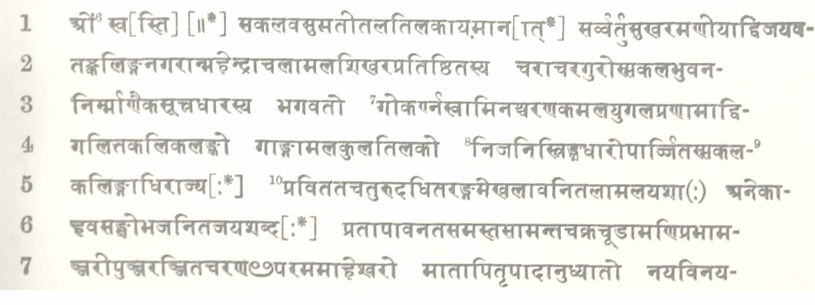|
The Indian Analyst
|
North Indian Inscriptions |
CHICACOLE PLATES OF DEVENDRAVARMAN. ......The plates record the grant of the village of Poppaṅgika in Saraümaṭamba, a subdivision of the district of Krôshṭukavartanî (l. 9), as an agrahâra (l. 10) to six Brâhmaṇa brothers, who resided at Kaliṅgânagara (l. 11) and belonged to the Chhandôga school (l. 12). The grant was made at Kaliṅganagara1 (l. 2) by one of the kings of Kaliṅga (l. 5) of the Gâṅga family (l. 4),― the Mahârâja Dêvêndravarman, who was the son of Guṇârṇava (l. 8). The date of the grant was the eighth tithi of the bright fortnight of the month of Mâgha (l. 11), during (the sun’s) progress to the north (udag-ayana).2 The edict itself was engrossed and issued in “the one-hundred-and-eighty-third year (in words and numerical symbols) of the reign, on the twentieth (solar) day (in words and figures) of the month of Śrâvaṇa” (l. 26 f.). This second date is subsequent to the first by at least several months. Unfortunately, neither of the two dates contains any elements which admit of verification, and which might thus help to fix the initial point of the Gâṅga era. The second date is preceded by the names of the writer of the edict and of an official witness (l. 24 f.), and followed by the name of the engraver (l. 27). ......Owing to the uncertainty in which the Gâṅga era is still involved, nothing can at present be said about Dêvêndravarman, the son of Guṇârnava, but that he must be distinct from Dêvêndravarman, the son Anantavarman,3 and that the name Guṇârṇava occurs twice in the list of the ancestors of Chôḍagaṅga of Kalinga.4
TEXT.5
......1 The vowel of the third syllable is short here, as in the majority of other instances, while it is
long in line 11,
in the Chicacole plates of Anantavarman’s son Dêvêndravarman (Ind. Ant. Vol. XIII. p. 275, text line 2),
in
the Alamanda plates (ante, p. 18, text line 2), and in the Parlâ-Kimeḍi plates of Vajrahasta, which will
shortly be
published by Professor Kielhorn (No. 31 below).
| ||||||||||||||||||||||||||||||||||||||||||||||||||||||||||||||||||||||||||||
| > |
|
>
|








